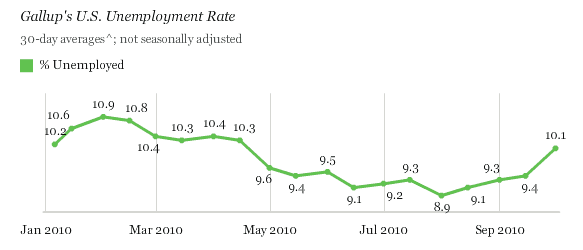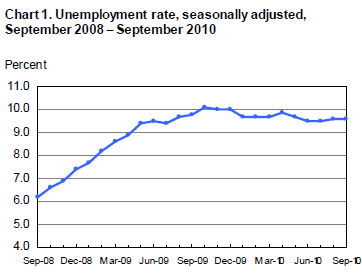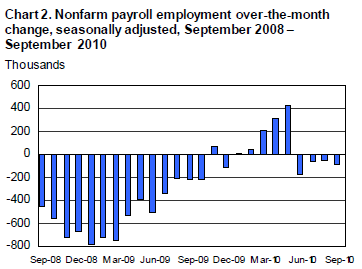Fantastic Economic News, U.S. Nonfarm Payrolls Decline by 95,000
Economics / US Economy Oct 08, 2010 - 01:45 PM GMTBy: Mike_Shedlock
 Today we have fantastic news from the BLS that the economy shed 95,000 jobs, far weaker than the economists' consensus expectation of a mere 5,000 drop.
Today we have fantastic news from the BLS that the economy shed 95,000 jobs, far weaker than the economists' consensus expectation of a mere 5,000 drop.
Moreover, part-time workers for economic reasons increased by a whopping 612,000 workers, much higher than an recent numbers and also higher than a year ago. The effect of rising part-time work is the effective unemployment rate shot up .4% to 17.1%
Shedding jobs is great news because it seals the fate for Bernanke's Quantitative Easing program that is all but guaranteed to create jobs and drive the stock market higher according to the consensus opinion of Wall Street cheerleaders.
The worse the news, the better off the economy would be. Unfortunately, the official unemployment rate stayed flat at 9.6%. Had it blasted higher to 9.9% or better yet 10.1%, I am sure the stock market wold be up 3% right now.
To recap, the only way the economy can get better is if it gets worse first. So bad news is good news, and good news shows the bad news worked. Thus, all news is good news. Such is the magic of QE.
In case you missed the sarcasm, and think stocks are cheap and QE will blast the market higher until the economy improves, please consider the following missives:
- Sure Thing?!
- Hussman calls for 10-Year S&P 500 Total Return in the Low 5% Area; Thoughts on Risk Management
- Lessons Not Learned - No Failure Too Great to Admit It
- Bernanke says Lawmakers Should Consider Rules on Fiscal Limits; Expect Hissy Fit from Krugman; Bernanke Pisses in the Wind
Employers in U.S. Cut More Jobs Than Forecast
Bloomberg reports Employers in U.S. Cut More Jobs Than Forecast
The U.S. lost more jobs than forecast in September, reflecting a decline in government payrolls that shows the damage being done by rising budget deficits.
Employers fired 95,000 workers after a revised 57,000 decrease in August, Labor Department figures in Washington showed today. The median estimate of economists surveyed by Bloomberg News called for a 5,000 drop. The unemployment rate held at 9.6 percent.
Private payrolls that exclude government agencies climbed 64,000, less than forecast, underscoring the concern expressed by some Federal Reserve policy makers that the rebound from the worst recession since the 1930s has been too slow and may require easier monetary policy. Unemployment forecast to average at least 9 percent through 2011 may restrain consumer spending, the biggest part of the economy.
The Labor Department today also published its preliminary estimate for the annual benchmark revisions to payrolls that will be issued in February. They showed the economy may have lost an additional 366,000 jobs in the 12 months ended March 2010. The data currently show a 1.7 million drop in employment during that time.
"If we're only creating jobs at this pace, the unemployment rate is going to go higher," said Nigel Gault, chief U.S. economist at IHS Global Insight in Lexington, Massachusetts, who forecast a 65,000 gain in private payrolls. "We aren't creating enough jobs to keep it steady."
The unemployment rate is forecast to average 9.2 percent next year, according to the median forecast in a Bloomberg Survey of economists last month.
What's Not To Like?
The above article is chock full of great news such as downward revisions for August on top of an additional 366,000 jobs in the 12 months ended March 2010 (especially when economists like Zandi said that revisions would surprise to the upside).
More seriously, the only thing keeping the unemployment rate "low" at 9.6% is a huge drop in the participation rate this year with people (at least according to the BLS) dropping out of the economy at a staggering rate.
BLS vs. Gallup
One more thing before diving into the actual BLS report. Here is something I wrote yesterday: Gallup Survey Shows Unemployment Jumps From 9.4% to 10.1%
As economists up their forecasts for tomorrow's jobs report, I am lowering mine.
First, the recent ADP report suggests private nonfarm employment dropped by 39,000 with expectations of a gain.
Second, Gallup Finds U.S. Unemployment at 10.1% in September
Unemployment, as measured by Gallup without seasonal adjustment, increased to 10.1% in September -- up sharply from 9.3% in August and 8.9% in July. Much of this increase came during the second half of the month -- the unemployment rate was 9.4% in mid-September -- and therefore is unlikely to be picked up in the government's unemployment report on Friday.
The increase in the unemployment rate component of Gallup's underemployment measure is partially offset by fewer part-time workers, 8.7%, now wanting full-time work, down from 9.3% in August and 9.5% at the end of July. ....
Looking ahead, I expect economic and jobs conditions to worsen, and for new all time highs in the unemployment rate.
BLS September Report
Please consider the Bureau of Labor Statistics (BLS) September 2010 Employment Report.
Nonfarm payroll employment edged down (-95,000) in September, and the unemployment rate was unchanged at 9.6 percent, the U.S. Bureau of Labor Statistics reported today. Government employment declined (-159,000), reflecting both a drop in the number of temporary jobs for Census 2010 and job
losses in local government. Private-sector payroll employment continued to trend up modestly (+64,000).
Unemployment Rate - Seasonally Adjusted
Nonfarm Payroll Employment - Seasonally Adjusted
Since September 2009, temporary help services employment has risen by 362,000.
Establishment Data
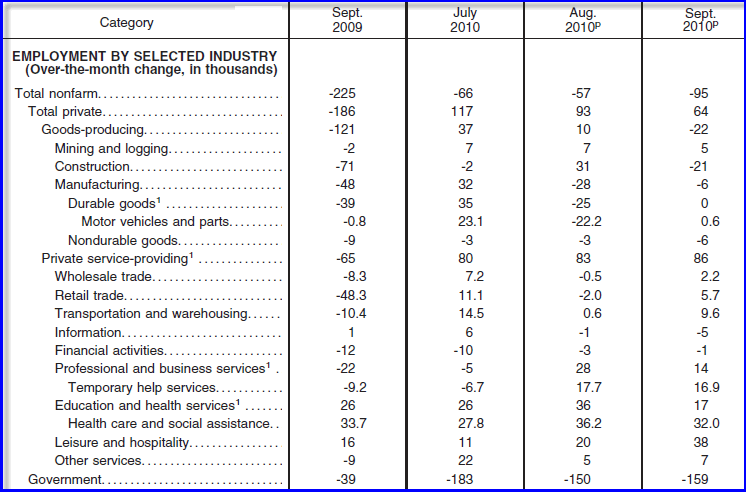
Highlights
- 95,000 jobs were lost
- 21,000 construction jobs were lost
- 6,000 manufacturing jobs were lost
- 86,000 service providing jobs were added
- 5,700 retail trade jobs were added
- 14,000 professional and business services jobs were added
- 17,000 education and health services jobs were added
- 38,000 leisure and hospitality jobs were added
- 159,000 government jobs were lost. Of them, 77,000 were temporary census workers
Note: some of the above categories overlap as shown in the preceding chart, so do not attempt to total them up.
Index of Aggregate Weekly Hours
Production and non-supervisory work hours were flat at 33.5 hours. Average hourly earnings rose $.01 at $19.10.
BLS Birth-Death Model Black Box
For those unfamiliar with the birth/death model, monthly jobs adjustments are made by the BLS based on economic assumptions about the birth and death of businesses (not individuals).
Birth Death Model Revisions 2009
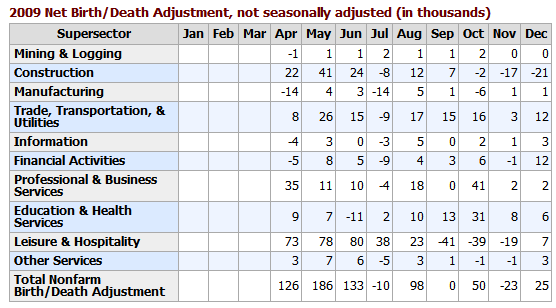
Birth Death Model Revisions 2010
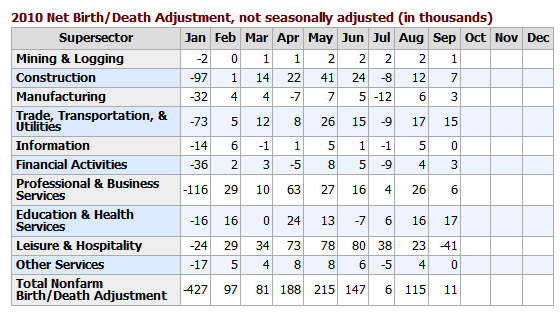
Birth/Death Model Revisions
The BLS Birth/Death Model methodology is so screwed up and there have been so many revisions and up it is pointless to further comment other than to repeat a few general statements.
Please note that one cannot subtract or add birth death revisions to the reported totals and get a meaningful answer. One set of numbers is seasonally adjusted the other is not. In the black box the BLS combines the two coming out with a total. The Birth Death numbers influence the overall totals but the math is not as simple as it appears and the effect is nowhere near as big as it might logically appear at first glance.
Birth/Death assumptions are supposedly made according to estimates of where the BLS thinks we are in the economic cycle. Theory is one thing. Practice is clearly another.
The BLS knows full well their model is screwed up. Yet they stick with it, hoping that someday it will work again. The problem is the model assumes this is a normal recovery. It isn't, and it won't be.
Thus we have a third major revision to prior birth-death adjustments.
Here is a table from today's jobs report.
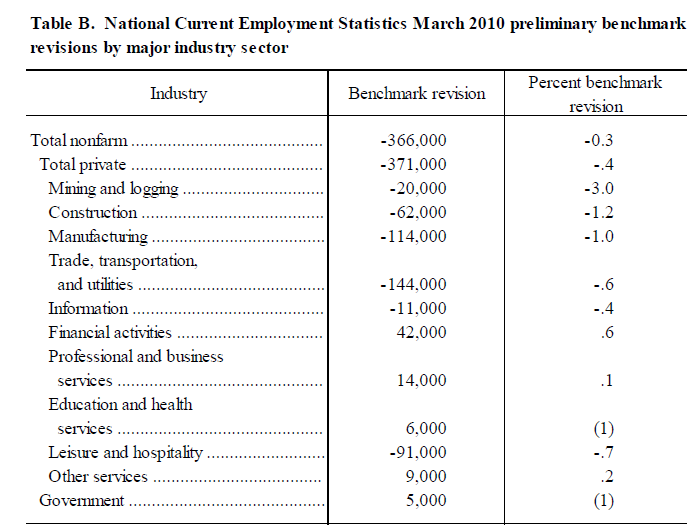
Household Data
The number of unemployed persons, at 14.8 million, was essentially unchanged in September, and the unemployment rate held at 9.6 percent.
The number of long-term unemployed (those jobless for 27 weeks and over), at 6.1 million, was little changed over the month but was down by 640,000 since a series high of 6.8 million in May. In September, 41.7 percent of unemployed persons had been jobless for 27 weeks or more.
In September, both the civilian labor force participation rate, at 64.7 percent, and the employment population ratio, at 58.5 percent, were unchanged.
Involuntary Part-Time Workers
The number of persons employed part time for economic reasons (sometimes referred to as involuntary part-time workers) rose by 612,000 over the month to 9.5 million. Over the past 2 months, the number of such workers has increased by 943,000. These individuals were working part time because their hours had been cut back or because they were unable to find a full-time job.
[Mish Note: In January the number was 8.3 million]
Persons Not in the Labor Force
About 2.5 million persons were marginally attached to the labor force in September, up from 2.2 million a year earlier. These individuals were not in the labor
force, wanted and were available for work, and had looked for a job sometime in the prior 12 months. They were not counted as unemployed because they had not searched for work in the 4 weeks preceding the survey.
Table A-8 Part Time Status
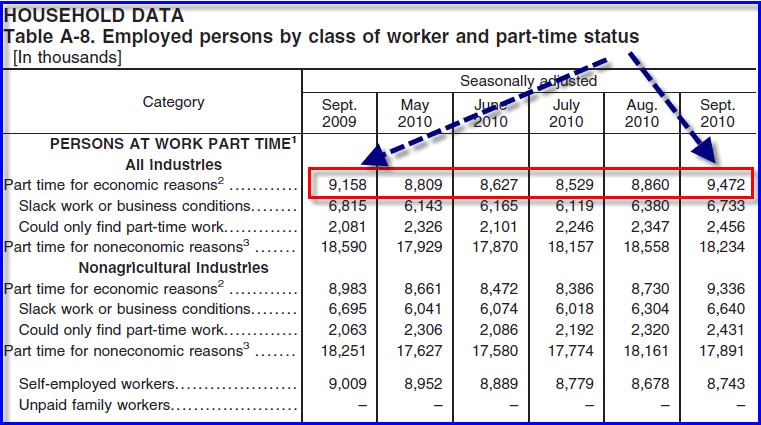
612,000 more people are working part-time for economic reasons than last month. This was a massive jump from June, July, and August, and even from one year ago today!
There are now 9,4720,00 workers whose hours may rise before those companies start hiring more workers.
Table A-15
Table A-15 is where one can find a better approximation of what the unemployment rate really is.
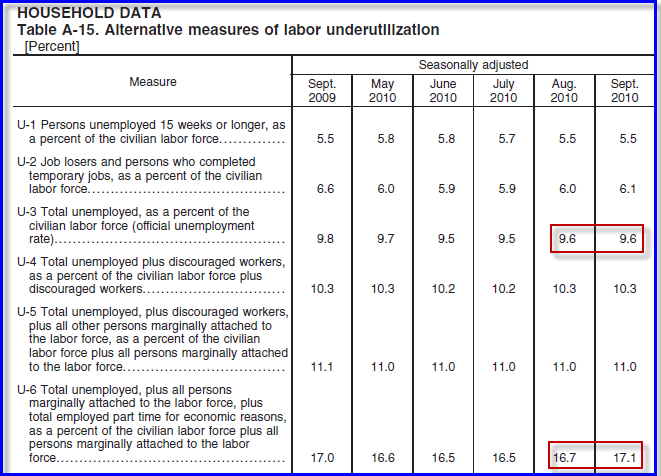
Grim Statistics
The official unemployment rate is 9.6%. However, if you start counting all the people that want a job but gave up, all the people with part-time jobs that want a full-time job, all the people who dropped off the unemployment rolls because their unemployment benefits ran out, etc., you get a closer picture of what the unemployment rate is. That number is in the last row labeled U-6.
It reflects how unemployment feels to the average Joe on the street. U-6 is 17.1%, up a whopping .4 from last month.
Looking ahead, there is no driver for jobs. Moreover, states are in forced cutback mode on account of shrinking revenues and unfunded pension obligations. Shrinking government jobs and benefits at the state and local level is a much needed adjustment. Those cutbacks will weigh on employment and consumer spending for quite some time.
Expect to see structurally high unemployment for years to come.
Keep in mind that huge cuts in public sector jobs and benefits at the city, county, and state level are on the way. These are badly needed adjustments. However, economists will not see it that way, nor will the politicians.
Recap
The private sector hiring increase of 64,0000 is very weak for a recovery. It is consistent with rising unemployment rate. Part-Time workers for economic reasons increased by a whopping 612,000 workers, much higher than an recent numbers and also higher than a year ago. The effect of rising part-time work is the effective unemployment rate shot up .4% to 17.1%
This was all such good news, the stock market is higher.
By Mike "Mish" Shedlock
http://globaleconomicanalysis.blogspot.com
Click Here To Scroll Thru My Recent Post ListMike Shedlock / Mish is a registered investment advisor representative for SitkaPacific Capital Management . Sitka Pacific is an asset management firm whose goal is strong performance and low volatility, regardless of market direction.
Visit Sitka Pacific's Account Management Page to learn more about wealth management and capital preservation strategies of Sitka Pacific.
I do weekly podcasts every Thursday on HoweStreet and a brief 7 minute segment on Saturday on CKNW AM 980 in Vancouver.
When not writing about stocks or the economy I spends a great deal of time on photography and in the garden. I have over 80 magazine and book cover credits. Some of my Wisconsin and gardening images can be seen at MichaelShedlock.com .
© 2010 Mike Shedlock, All Rights Reserved.
© 2005-2022 http://www.MarketOracle.co.uk - The Market Oracle is a FREE Daily Financial Markets Analysis & Forecasting online publication.




